In the first installment with Jessica Hausner on three of her feature films before her latest, the bewitching Club Zero (European Film Award Best Original Score to Markus Binder), we start the conversation with Lourdes, costumes, as always, designed by Tanja Hausner (recent work includes Frauke Finsterwalder’s Sisi & I, Ulrich Seidl’s Rimini and Sparta), cinematography by Martin Gschlacht (Silver Bear winner in the 2024 Berlin Film Festival for Veronika Franz and Severin Fiala’s The Devil’s Bath, Des Teufels Bad, screening in this year’s Tribeca Film Festival), sound design by Erik Mischijew (Maren Ade’s multiple European Film Awards winner, Oscar and BAFTA nominated Toni Erdmann, starring Sandra Hüller and Peter Simonischek), and production design by Katharina Wöppermann (Shirin Neshat and Shoja Azari’s Women Without Men).
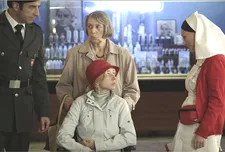 |
| Kuno (Bruno Todeschini) with Christine (Sylvie Testud), Frau Hartl (Gilette Barbier) and Cécile (Elina Löwensohn) |
Maria (Léa Seydoux), a newcomer to the Order of Malta, takes care of wheelchair-bound Christine (Sylvie Testud), during her pilgrimage to Lourdes. As in many of Hausner’s films, miracles, ghosts, the supernatural and the wondrous may lurk just behind the curtain or not exist at all. When Christine, who always stands out in her fire engine red bucket hat, can suddenly walk and thus wins the prize for Best Pilgrim, it may be the work of Our Lady of Lourdes during a visit in one of the Pyrenees caves, it may be a case of Münchhausen Syndrome, or perhaps the bewitching charms of Kuno (Bruno Todeschini), Knight of the Order of Malta, whose attention she completes for with Maria.
From Vienna, Jessica Hausner joined me on Zoom for an in-depth conversation on Hotel, Lovely Rita, and Lourdes.
Anne-Katrin Titze: Good to see you again!
Jessica Hausner: Yes, hello!
AKT: Do you see Lovely Rita, Hotel, and Lourdes as a trilogy?
JH: No, never thought about it like that.
AKT: When we spoke about Club Zero, Pied Piper of Hamlin, and Peter & the Wolf, you said that in all your films there is a connection to fairy tales in general or to a specific tale. While watching these three films of yours I was wondering which tales you may have been thinking about for each.
JH: Well, in Lourdes I was thinking about the story of Heidi. You know that Swiss story about the girl from the countryside who comes to the big city and she is the friend of a paralysed girl called Clara. So this was a story that helped me to think about the characters in Lourdes. The girl in the wheelchair is Clara and her helper …
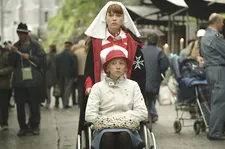 |
| Maria (Léa Seydoux) pushes Christine’s (Sylvie Testud) wheelchair through Lourdes |
AKT: … Léa Seydoux is Heidi!
JH: Léa Seydoux is Heidi!
AKT: I never would have thought of that. That is so interesting.
JH: And the knight who dances with her is Peter.
AKT: Geissenpeter!
JH: Exactly. And the old lady is the Almöhi. An old person who is warm-hearted but at the same time a little bit spooky. Those very archetypal characters in that story helped me to find the characters for my film Lourdes.
AKT: The ending of Lourdes is brilliant because it works on so many levels. It feels like the Ghost of Christmas Past and the Ghost of Christmas Future with the Knight of Malta and the woman in the wheelchair, while Léa sings Felicità. How did you come up with this ending?
JH: I always have a very short idea before I start to write the script of a film or start the research. There’s sometimes a very simple logline in the beginning of a film. For Lourdes it was a film about a miracle that might not be one. I remember that I was reading only the back summary of a book, of a novel by Émile Zola. He wrote a book about Lourdes. It’s a very typical book analysing the hypocrisy of people who believe in miracles. And of course the book proves that there are no miracles. On the back of the book there was a summary and that summary was exactly my logline.
I never read the book, I already knew what was inside. Sometimes I like to read summaries because novels are much more complicated than films. Films work more like summaries. Films’ stories are often very simple - it doesn’t need to be complex, on the contrary. And that summary included that failure in the end. I knew it had to end with exactly that disappointment. The miracle might not have worked.
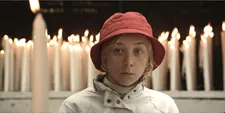 |
| Christine (Sylvie Testud) |
On the other hand I wanted to say that even if she’s falling back into her paralysis, it’s still the question of some people if then maybe it was not a miracle. So they want to keep the idea or the hope about the miracle. I think that was the basic idea about that whole film. Yes, there is a miracle, but in the end we doubt if there was one after all.
AKT: The prize for the best pilgrim - making it a competition - is funny and absurd! How did you get permission to film in Lourdes, in the spaces for the pilgrims? Was it difficult?
JH: The party in the end was not in Lourdes, that was in another place. For the research I joined two or three pilgrimages to Lourdes and they do do that. Those ideas come all from the research I’ve done. They really give out the prize for the best pilgrim!
AKT: I thought you invented it.
JH: And being allowed to shoot there - during my research I visited the holy spaces several times and I told the authorities I was planning to do a film. I was quite honest right from the beginning. I also told them that I was a serious filmmaker, that my aim was not just to make fun of them. I also told them that I was not a believer, so it was all very clear right from the beginning that I was doing a serious investigation about what it is that is happening there. At some point they trusted me, collaborated with me and helped me a lot to be able to shoot the film.
AKT: Did you sing in a choir?
JH: No! But I like choirs because I used to have music only as a source music so I always had to think of occasions where I could have music in the scenes. Choirs are very beautiful and I can choose the songs, so it’s a very good way to have music in the film. Now since Little Joe I actually also have a composed score, but I still have my choir!
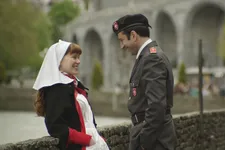 |
| Maria (Léa Seydoux) being charmed by Kuno (Bruno Todeschini) |
AKT: And your dance scenes too! From the disco moments to the seniors in Hotel, the dances in Lourdes and Club Zero. Speaking of overlapping tropes - I noticed necklaces. The cross necklace in Hotel, the saber tooth pendant Rita wears. And lamp timers are little Hausner specialties?
JH: There are several? The one in Lovely Rita …
AKT: … and in the basement of Hotel!
JH: Yes, but the necklaces are also part of the costume design. With Tanja Hausner, the costume designer, my sister, we always try to create an iconic look for the lead character. That’s why they sometimes have some special necklace, as you mentioned. Or the woman in Lourdes she has the red hat, so we always try to create something iconic as if it was a comic figure and you recognise her already because of the red hat.
AKT: When I spoke with Wendy Chuck, who does the costumes for Alexander Payne’s films, she told me about a necklace that is in The Holdovers, that was already worn in Election, many years ago. The red bucket hat in Lourdes indeed is very cartoonish and gives her a Paddington Bear flair. And then there are the uniforms.
JH: They also help to underline the stereotype. That it’s not about the individuals, as we said earlier, but my films are always about the question: what is my position within a society? And the uniform of course is a very visual sign of which group I belong to.
AKT: One last point about your sound design, which is really extraordinary. Especially disturbances that might not be noticeable yet. The sound design tells us that something is off here. Out of Silence is the company you have been using?
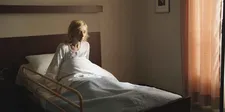 |
| Jessica Hausner on Christine (Sylvie Testud): ”For Lourdes it was a film about a miracle that might not be one.” |
JH: Yes, Erik Mischijew is the sound designer. That’s him, the company Out of Silence. He’s my sound designer from the very beginning. Lovely Rita, that was our first collaboration and he has a very interesting method because he records a lot of natural sounds.
For example I remember that in his apartment in the bathroom there was ventilation and the ventilation made a very weird clacking, flippering sound and he recoded that and we still use that sound! I think it’s in all my films, even in Club Zero again, that ventilation from his bathroom. He tunes it and he changes it a little bit, but he has a lot of weird sounds and he creates those atmospheres with them.
AKT: Will the ventilator be in the next film too? What are you working on right now?
JH: Now I’m working on a new project that will be an episode film, four episodes about work life. It shows people in different stories within their jobs. I would say it’s about self-exploitation and exploitation.
AKT: Which country and language will it be?
JH: It’s again, I would say, a film that is situated in Europe or maybe in the western world, the capitalist wealthy western world, the so-called free world.
AKT: Will there be some uniforms?
JH: Definitely!
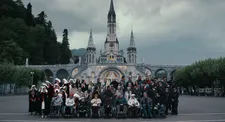 |
| Jessica Hausner on the pilgrimage at Lourdes: “They really give out the prize for the best pilgrim!” |
AKT: You told me that you always start each project with your sister and the clothes, so those are already mapped out?
JH: Yes.
AKT: Thank you! Looking forward to it!
JH: Thank you too for your interest in all the films! See you next time!
Coming up - Jessica Hausner on Hotel and Lovely Rita.
Read what Jessica Hausner had to say on food, fairy tales and parental fears, Pied Piper of Hamelin, wanting to be seen, casting Elsa Zylberstein and Mathieu Demy as parents, and more on Club Zero.
Read what Jessica Hausner had to say on her longtime collaborators, costume designer Tanja Hausner and cinematographer Martin Gschlacht plus Sidse Babett Knudsen and Peter & the Wolf in Club Zero.
Jessica Hausner’s Lovely Rita, Hotel, and Lourdes are available on the Film Movement Video on Demand platform.








![Jessica Hausner with Anne-Katrin Titze on Sylvie Testud’s Christine, Léa Seydoux’s Maria, Bruno Todeschini’s Kuno, and Gilette Barbier’s Frau Hartl in Lourdes: “I was thinking about the story of Heidi [by Johanna Spyri].”](/images/newsite/Jessica_Hausner_Anne-Katrin_Titze_600.webp)













